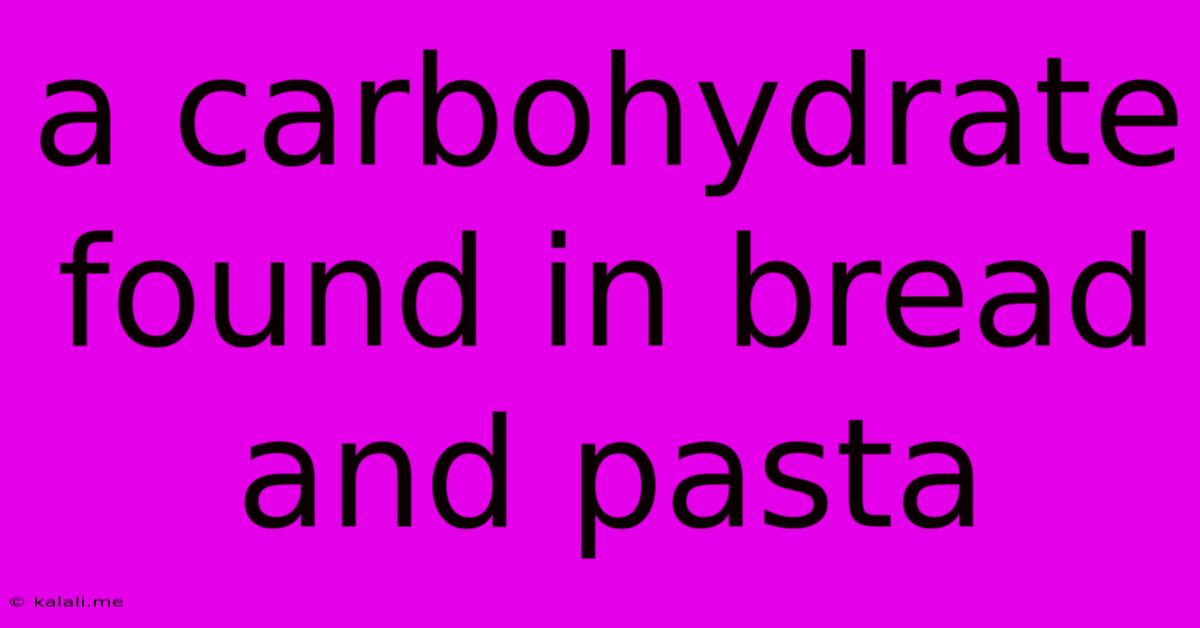A Carbohydrate Found In Bread And Pasta
Kalali
Jun 13, 2025 · 3 min read

Table of Contents
The Humble Carbohydrate: Understanding Starch in Bread and Pasta
Bread and pasta: staples of countless cuisines worldwide. But what exactly makes them so filling and satisfying? The answer lies in their primary carbohydrate component: starch. This article delves into the nature of starch, its role in bread and pasta production, and its impact on our bodies. Understanding starch will help you make informed choices about your diet and appreciate the science behind these everyday foods.
What is Starch?
Starch is a complex carbohydrate, a type of polysaccharide, composed of long chains of glucose molecules. These chains can be either linear (amylose) or branched (amylopectin). The ratio of amylose to amylopectin varies depending on the source of the starch, significantly affecting its properties. This ratio impacts factors like the texture of the final product, digestibility, and how it behaves during cooking.
Starch in Bread Making: From Flour to Loaf
Wheat flour, the primary ingredient in most breads, is rich in starch. When mixed with water, the starch granules absorb water and swell, forming a dough. The process of kneading further develops the gluten network, giving the bread its structure. During baking, the starch granules gelatinize, meaning they absorb even more water and irreversibly swell. This gelatinization is crucial for the soft, chewy texture of bread. Different types of wheat flour, and their varying starch compositions, contribute to different bread textures; for example, bread made with high-protein flour will have a chewier texture due to higher gluten content and different starch characteristics. The amylose and amylopectin content within the flour also play significant roles in influencing the final texture and crumb of the bread.
Starch and Pasta: Shaping the Dough
Similar to bread making, starch plays a vital role in pasta production. Semolina flour, a coarse flour made from durum wheat, is commonly used for pasta. This flour is particularly rich in starch and protein, contributing to the characteristic texture of pasta. The mixing of flour and water hydrates the starch granules, creating a dough that can be shaped and dried. During cooking, the starch granules gelatinize again, leading to the characteristic soft and tender texture of cooked pasta. The cooking time influences the degree of gelatinization, impacting the final texture and "bite" of the pasta. Different pasta shapes also influence cooking time and texture.
Digestibility and Glycemic Index
It's important to consider the digestibility of starch. Amylopectin, with its branched structure, is digested more rapidly than amylose, resulting in a quicker rise in blood sugar levels. This is reflected in the glycemic index (GI), a measure of how quickly a carbohydrate raises blood sugar. Foods with a high GI are digested and absorbed rapidly, while those with a low GI are digested more slowly. The type of starch and its processing influence its GI.
Beyond Wheat: Other Starch Sources
While wheat is a major source of starch in bread and pasta, other grains like rice, corn, and barley also contain starch and can be used to make bread and pasta alternatives. These alternative sources of starch may have varying nutritional profiles and textural qualities compared to wheat. Each offers a unique culinary experience and different nutritional benefits.
Conclusion
Starch is the fundamental carbohydrate in bread and pasta, driving their production and significantly impacting their texture and nutritional properties. Understanding the different types of starch, their role in food processing, and their impact on our bodies allows us to make more informed dietary decisions and appreciate the complex chemistry behind these everyday foods. By exploring the specifics of starch, we gain a deeper appreciation for the science and artistry involved in making these culinary staples.
Latest Posts
Latest Posts
-
What Are All The Multiples Of 7
Jun 14, 2025
-
What Is Square Root Of 61
Jun 14, 2025
-
What Do Plants Store Glucose As
Jun 14, 2025
-
Least Common Multiple Of 4 6 7
Jun 14, 2025
-
Emotional Intelligence Questions And Answers Pdf
Jun 14, 2025
Related Post
Thank you for visiting our website which covers about A Carbohydrate Found In Bread And Pasta . We hope the information provided has been useful to you. Feel free to contact us if you have any questions or need further assistance. See you next time and don't miss to bookmark.